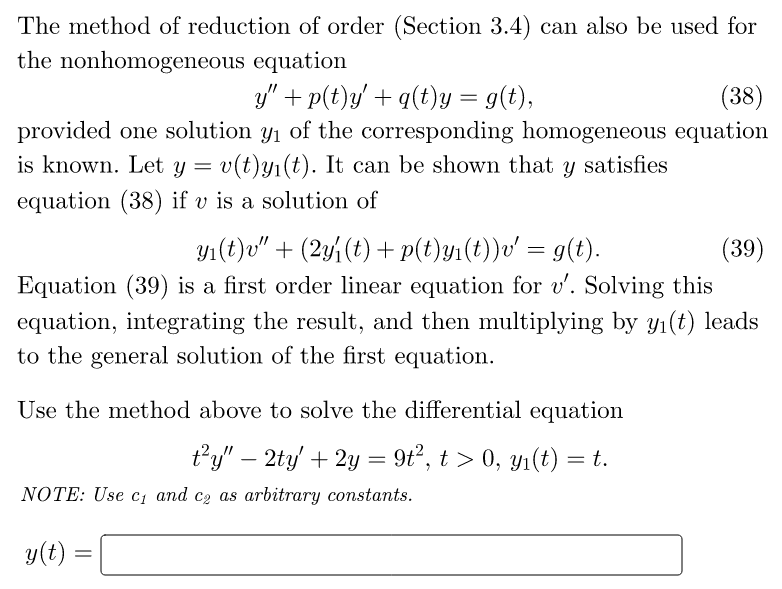The method of reduction of order (Section 3.4) can also be used for the nonhomogeneous equation y" + p(t)y' + q(t)y = g(t), (38) provided one solution y₁ of the corresponding homogeneous equation is known. Let y = v(t)yi(t). It can be shown that y satisfies equation (38) if v is a solution of y₁(t)v" + (2y{(t) + p(t)y₁(t))v' = g(t). (39) Equation (39) is a first order linear equation for v'. Solving this equation, integrating the result, and then multiplying by y₁(t) leads to the general solution of the first equation. Use the method above to solve the differential equation t²y" - 2ty' + 2y = 9t², t > 0, y₁(t) = t. NOTE: Use c₁ and ca as arbitrary constants. y(t) =
The method of reduction of order (Section 3.4) can also be used for the nonhomogeneous equation y" + p(t)y' + q(t)y = g(t), (38) provided one solution y₁ of the corresponding homogeneous equation is known. Let y = v(t)yi(t). It can be shown that y satisfies equation (38) if v is a solution of y₁(t)v" + (2y{(t) + p(t)y₁(t))v' = g(t). (39) Equation (39) is a first order linear equation for v'. Solving this equation, integrating the result, and then multiplying by y₁(t) leads to the general solution of the first equation. Use the method above to solve the differential equation t²y" - 2ty' + 2y = 9t², t > 0, y₁(t) = t. NOTE: Use c₁ and ca as arbitrary constants. y(t) =
Advanced Engineering Mathematics
10th Edition
ISBN:9780470458365
Author:Erwin Kreyszig
Publisher:Erwin Kreyszig
Chapter2: Second-order Linear Odes
Section: Chapter Questions
Problem 1RQ
Related questions
Question

Transcribed Image Text:The method of reduction of order (Section 3.4) can also be used for
the nonhomogeneous
equation
y" + p(t)y' + q(t)y = g(t),
(38)
provided one solution y₁ of the corresponding homogeneous equation
is known. Let y = v(t)yi(t). It can be shown that y satisfies
equation (38) if v is a solution of
y₁(t)v" + (2y{(t) + p(t)y₁(t))v' = g(t).
(39)
Equation (39) is a first order linear equation for v'. Solving this
equation, integrating the result, and then multiplying by y₁(t) leads
to the general solution of the first equation.
Use the method above to solve the differential equation
t²y" - 2ty' + 2y = 9t², t > 0, y₁(t) = t.
NOTE: Use c₁ and ca as arbitrary constants.
y(t)
=
Expert Solution
This question has been solved!
Explore an expertly crafted, step-by-step solution for a thorough understanding of key concepts.
Step by step
Solved in 2 steps with 2 images

Recommended textbooks for you

Advanced Engineering Mathematics
Advanced Math
ISBN:
9780470458365
Author:
Erwin Kreyszig
Publisher:
Wiley, John & Sons, Incorporated

Numerical Methods for Engineers
Advanced Math
ISBN:
9780073397924
Author:
Steven C. Chapra Dr., Raymond P. Canale
Publisher:
McGraw-Hill Education

Introductory Mathematics for Engineering Applicat…
Advanced Math
ISBN:
9781118141809
Author:
Nathan Klingbeil
Publisher:
WILEY

Advanced Engineering Mathematics
Advanced Math
ISBN:
9780470458365
Author:
Erwin Kreyszig
Publisher:
Wiley, John & Sons, Incorporated

Numerical Methods for Engineers
Advanced Math
ISBN:
9780073397924
Author:
Steven C. Chapra Dr., Raymond P. Canale
Publisher:
McGraw-Hill Education

Introductory Mathematics for Engineering Applicat…
Advanced Math
ISBN:
9781118141809
Author:
Nathan Klingbeil
Publisher:
WILEY

Mathematics For Machine Technology
Advanced Math
ISBN:
9781337798310
Author:
Peterson, John.
Publisher:
Cengage Learning,

